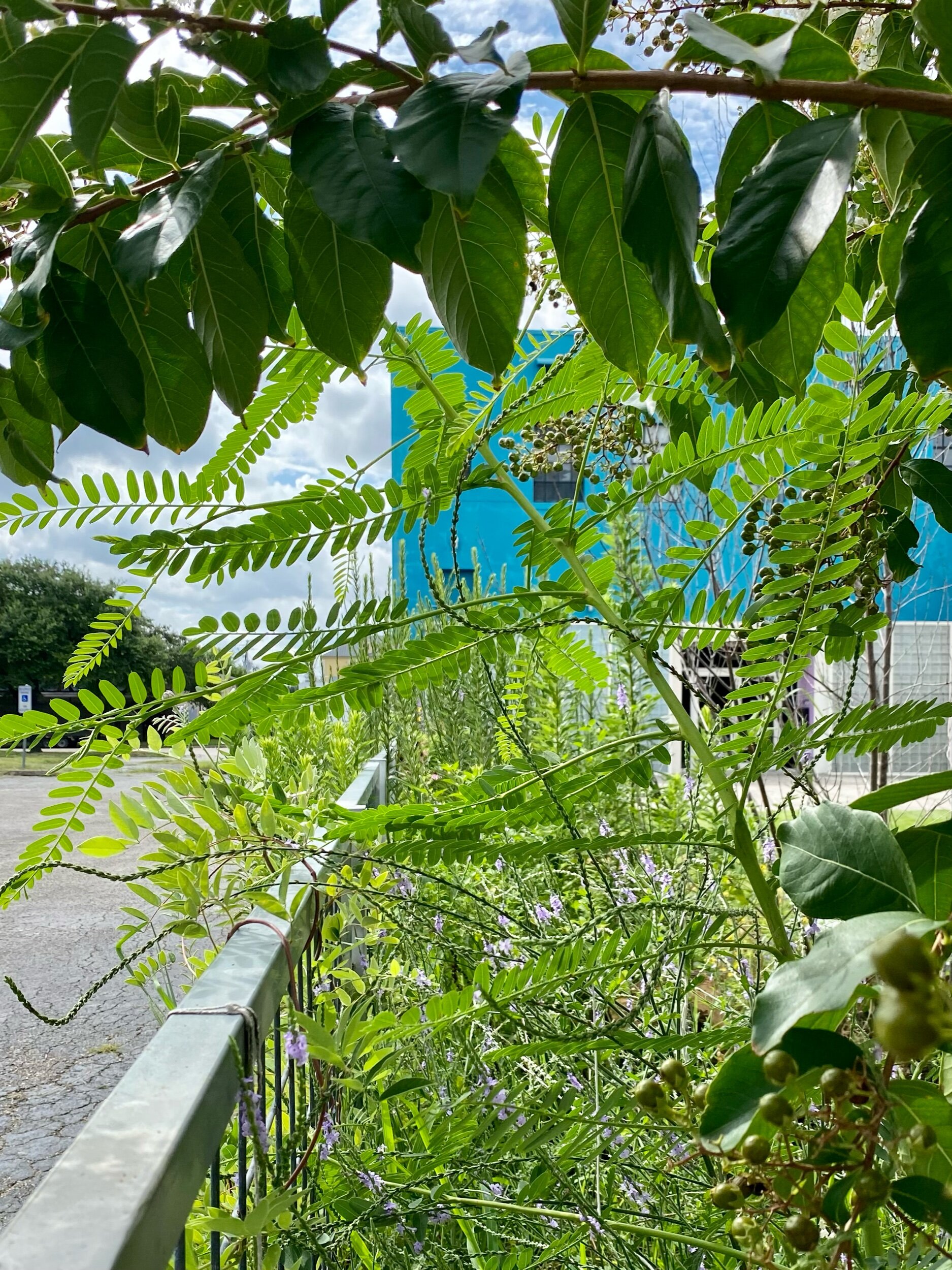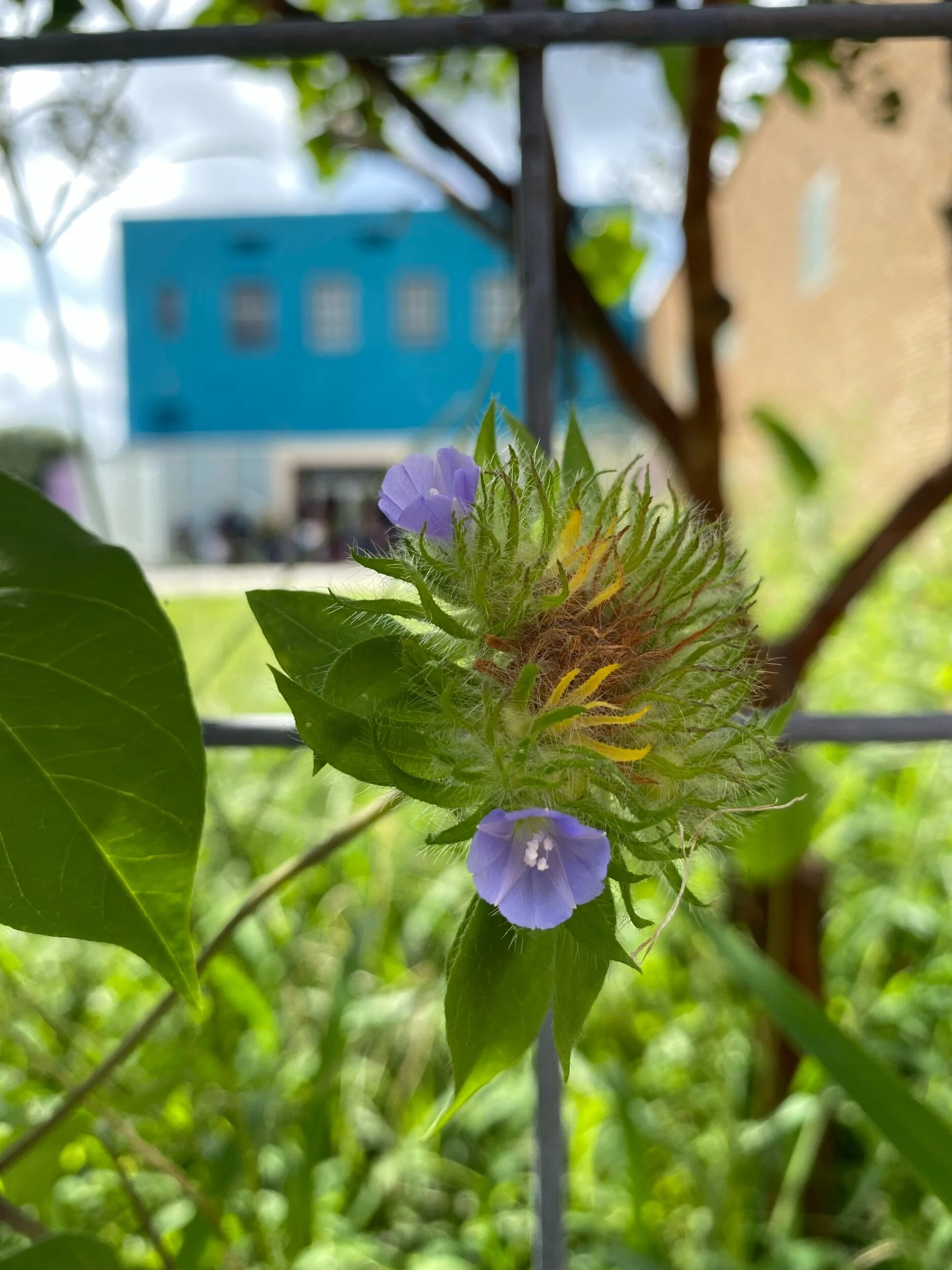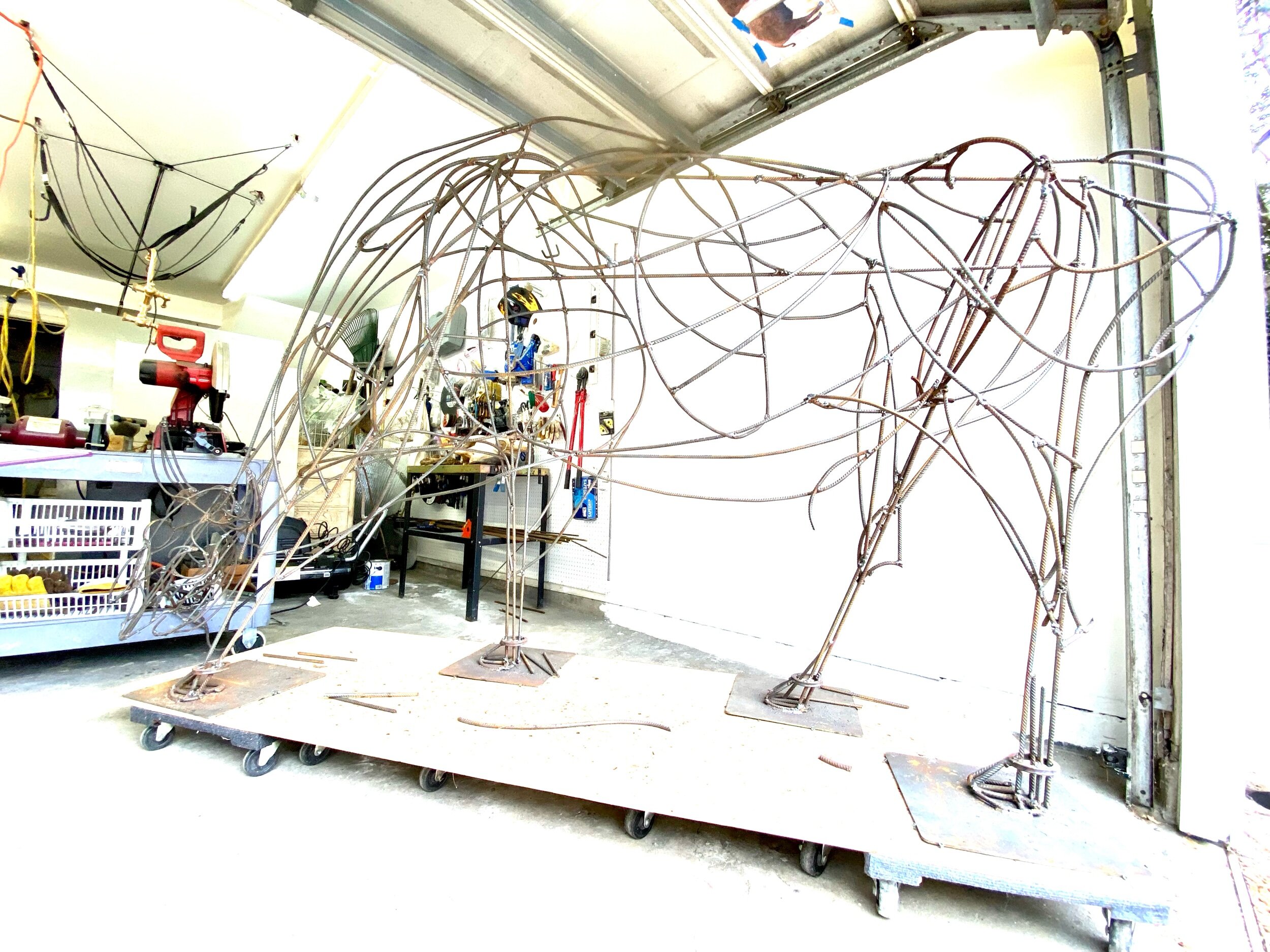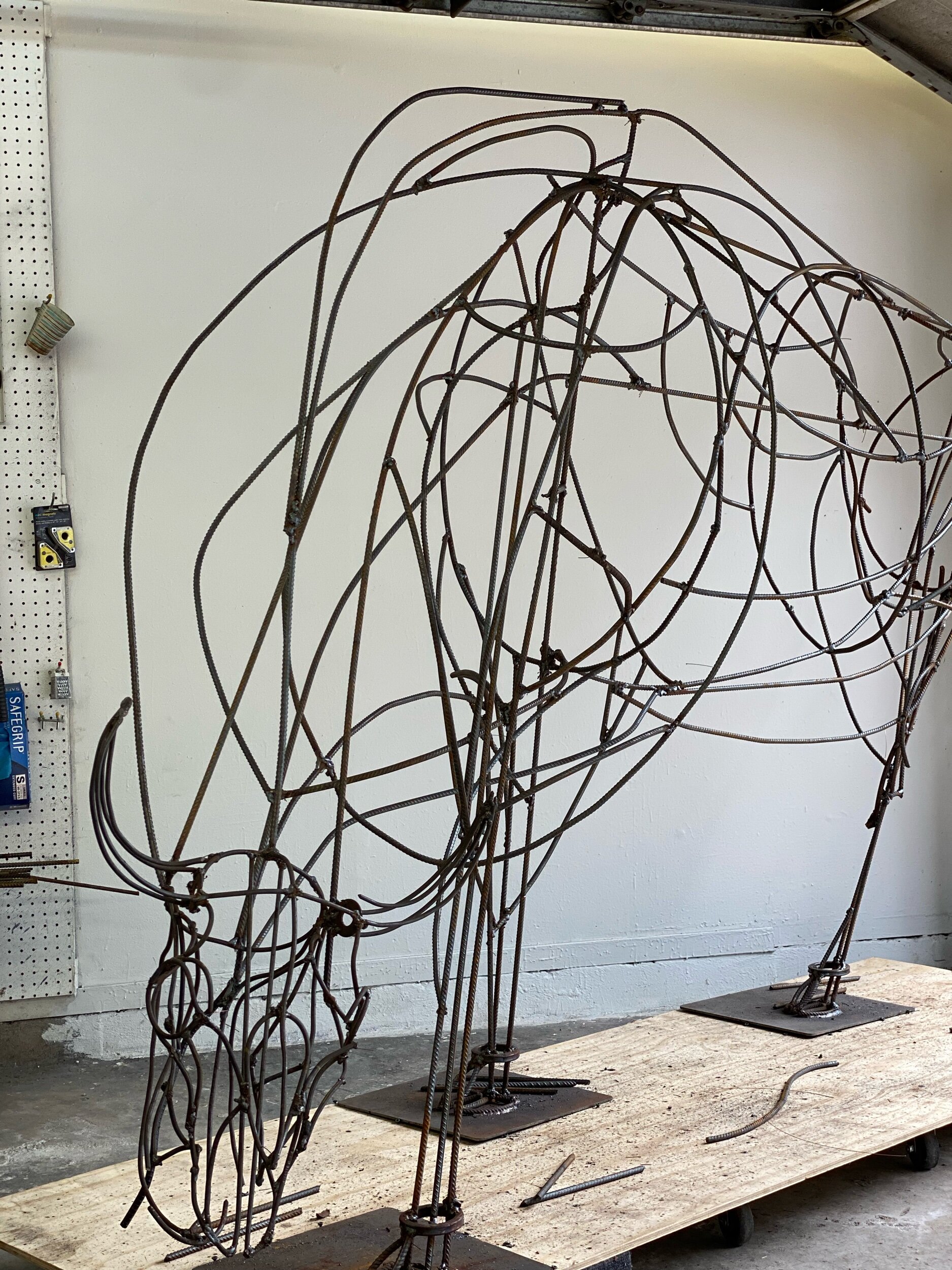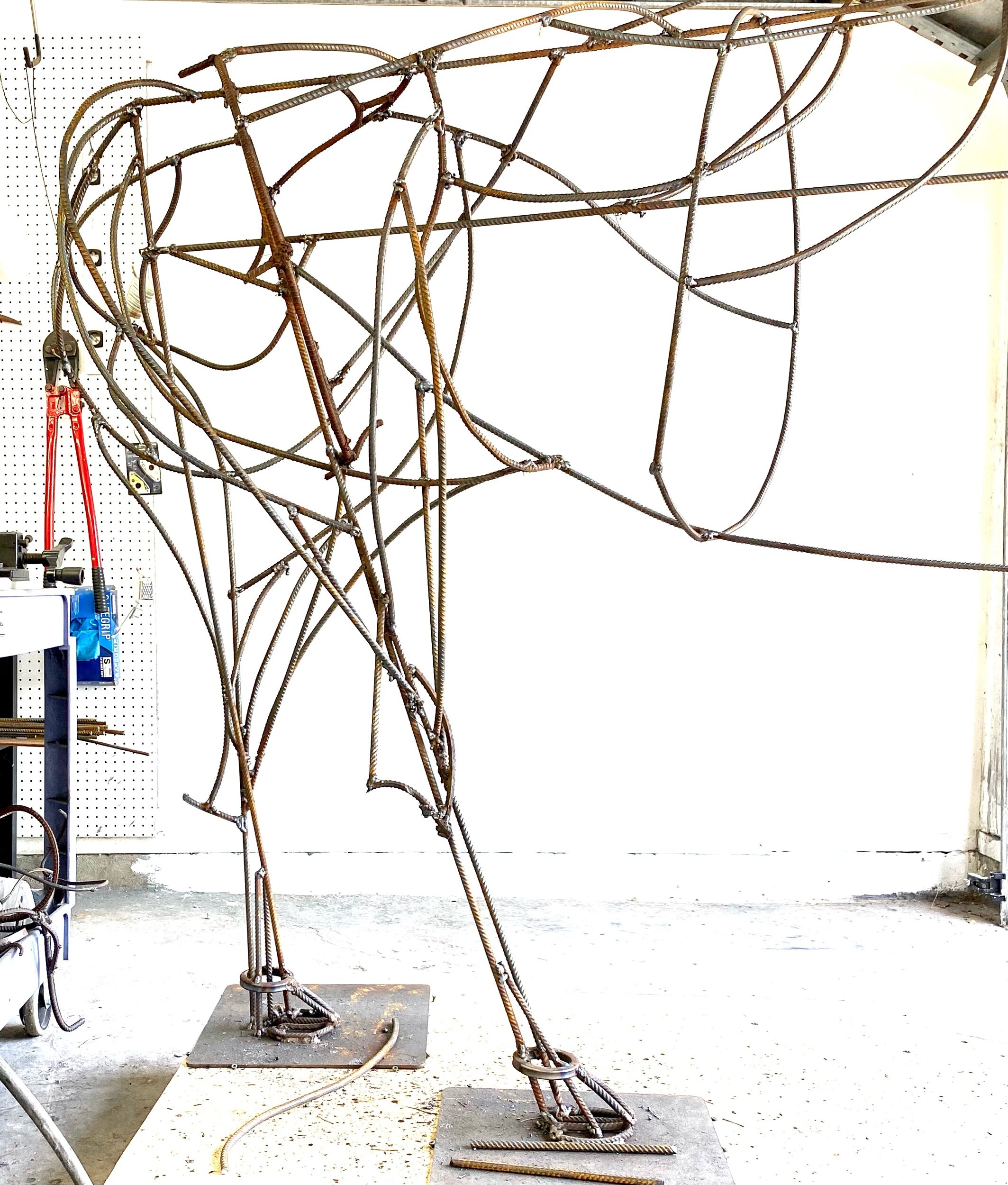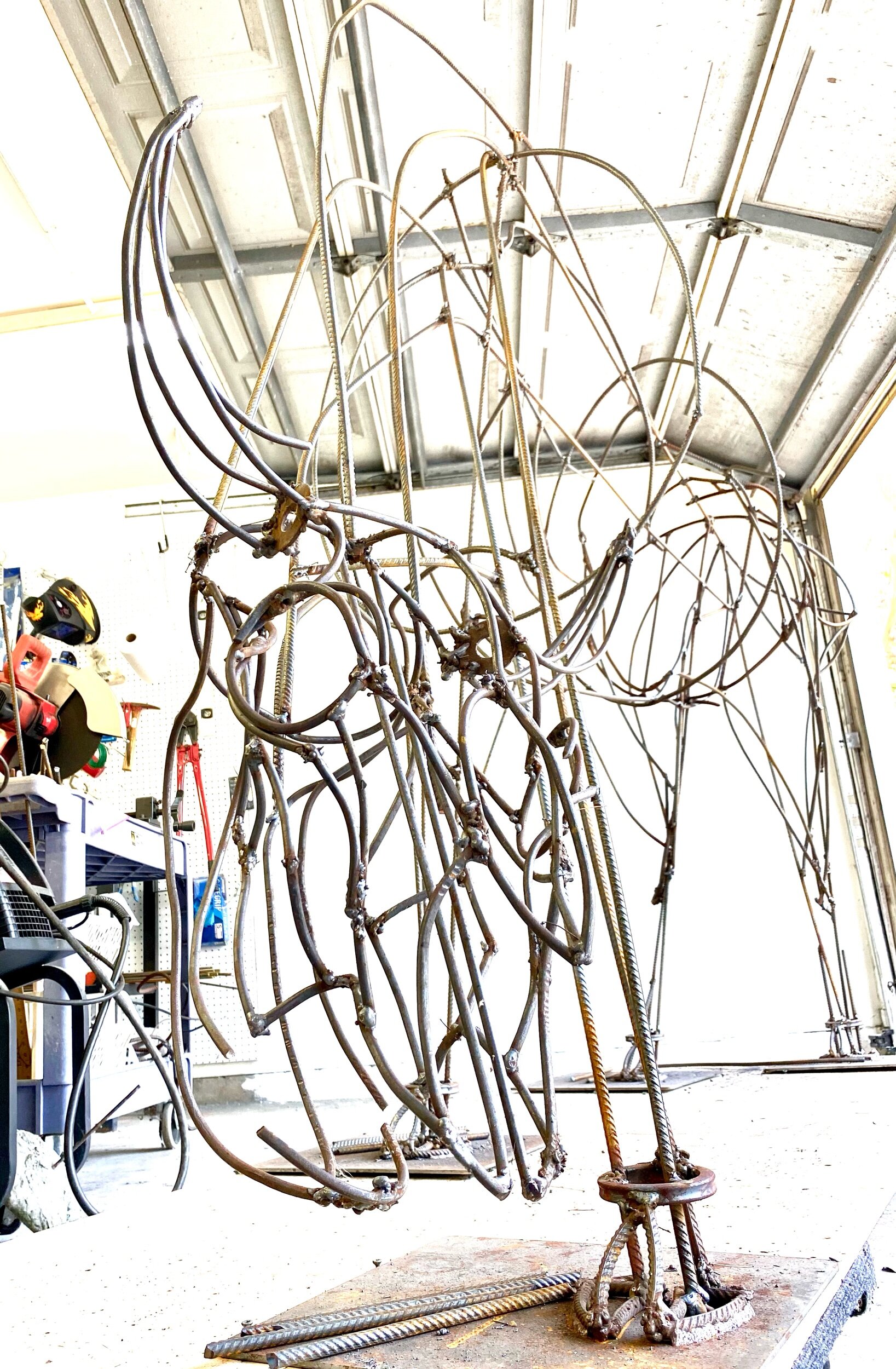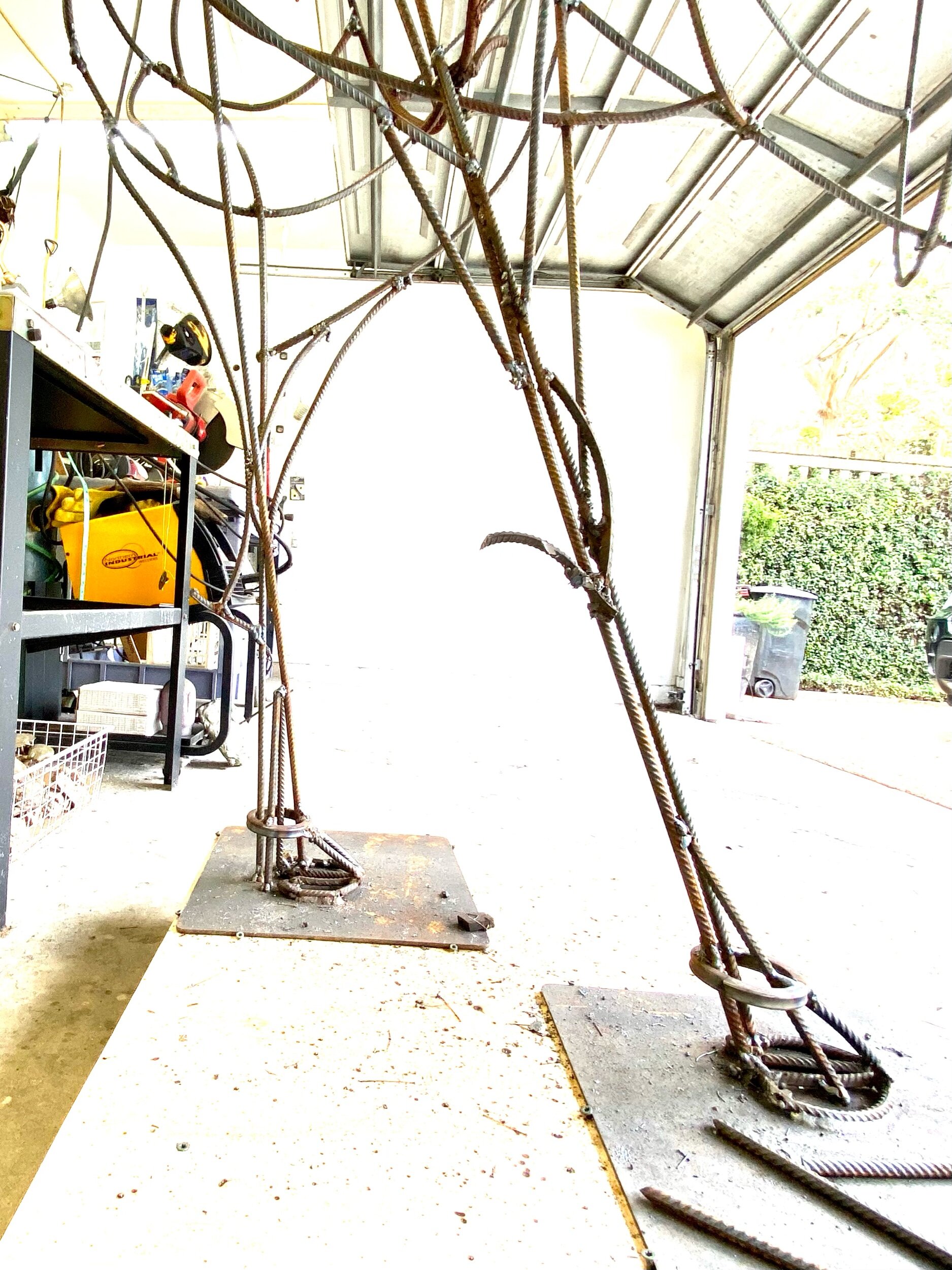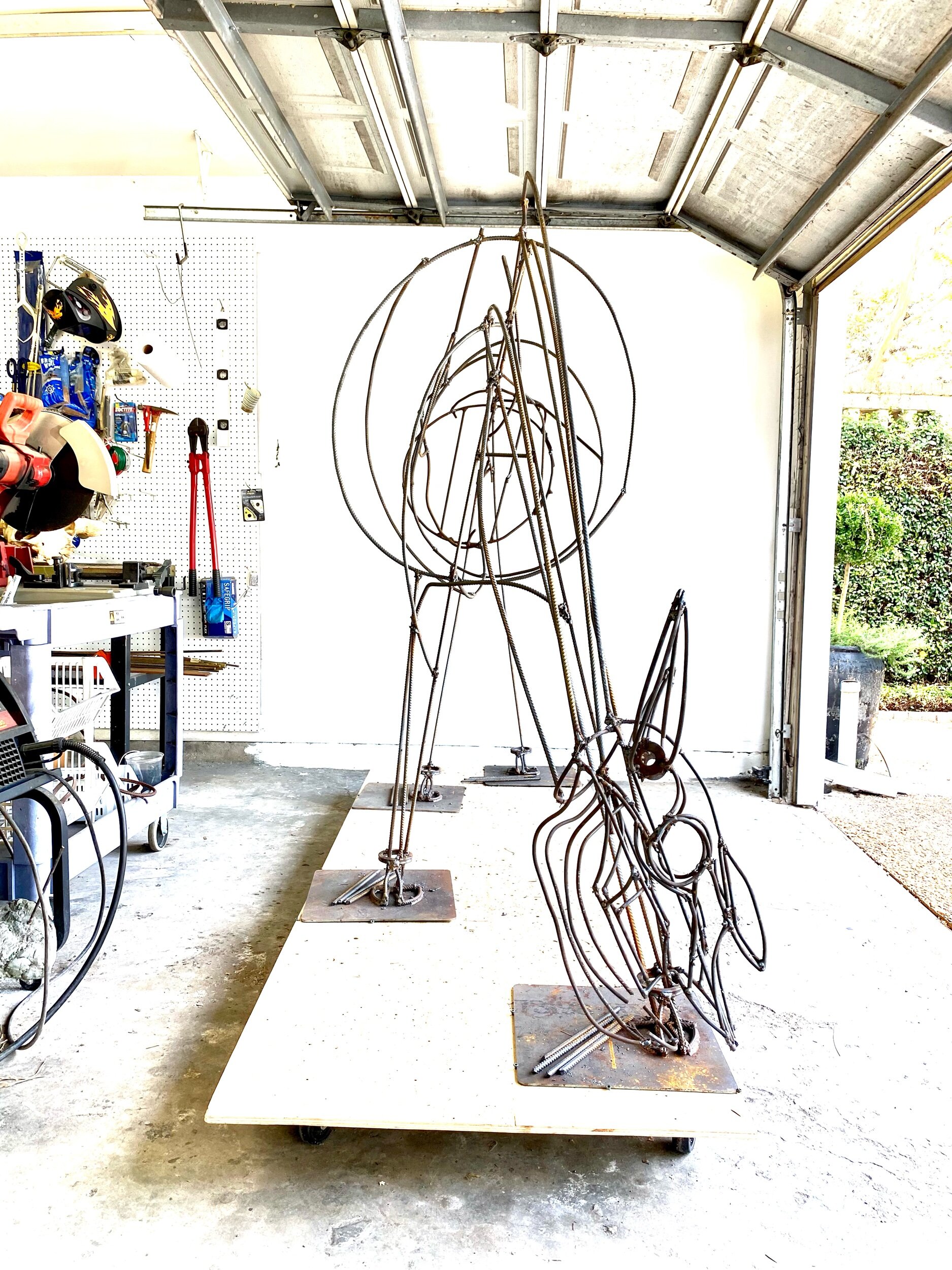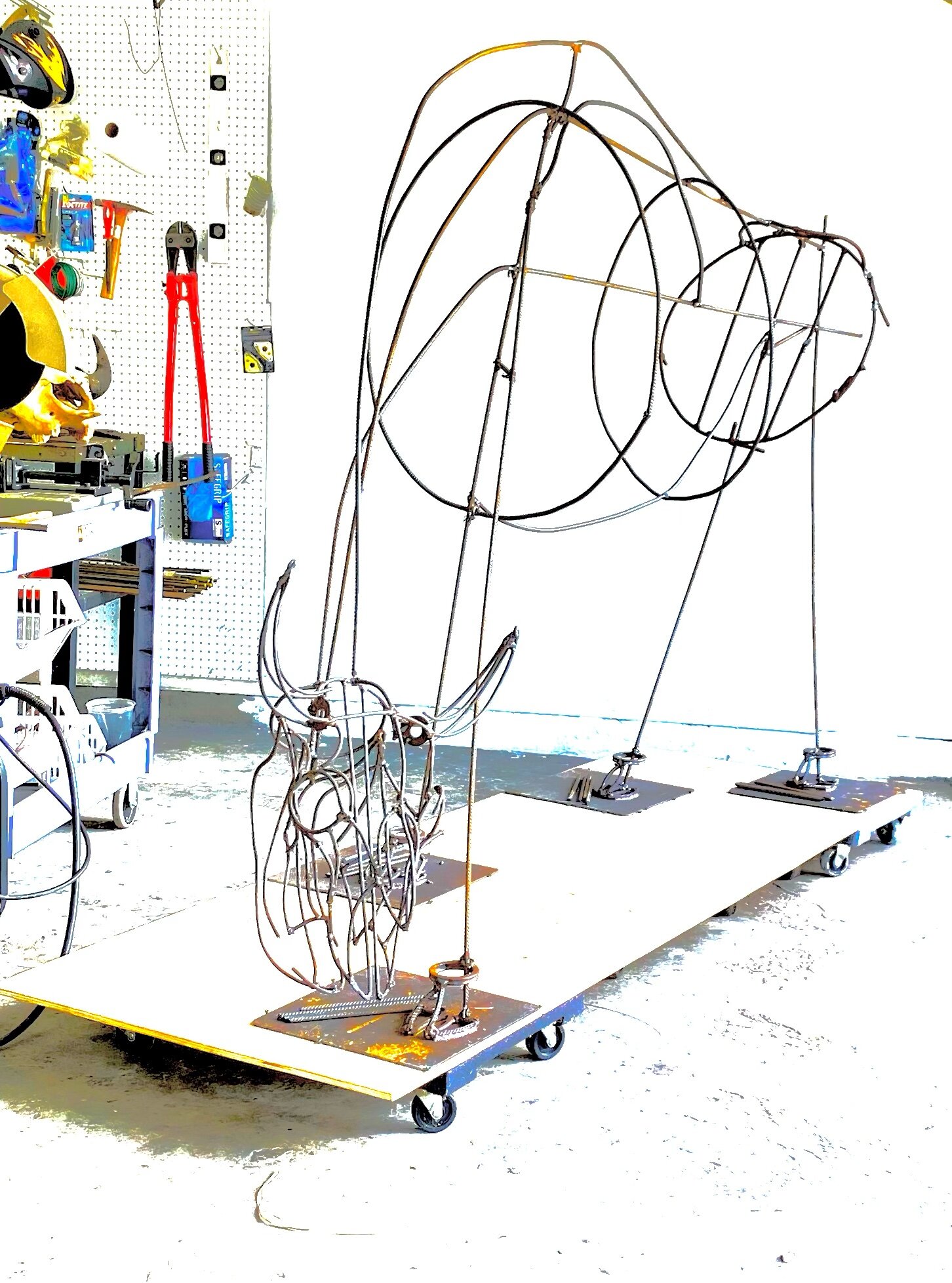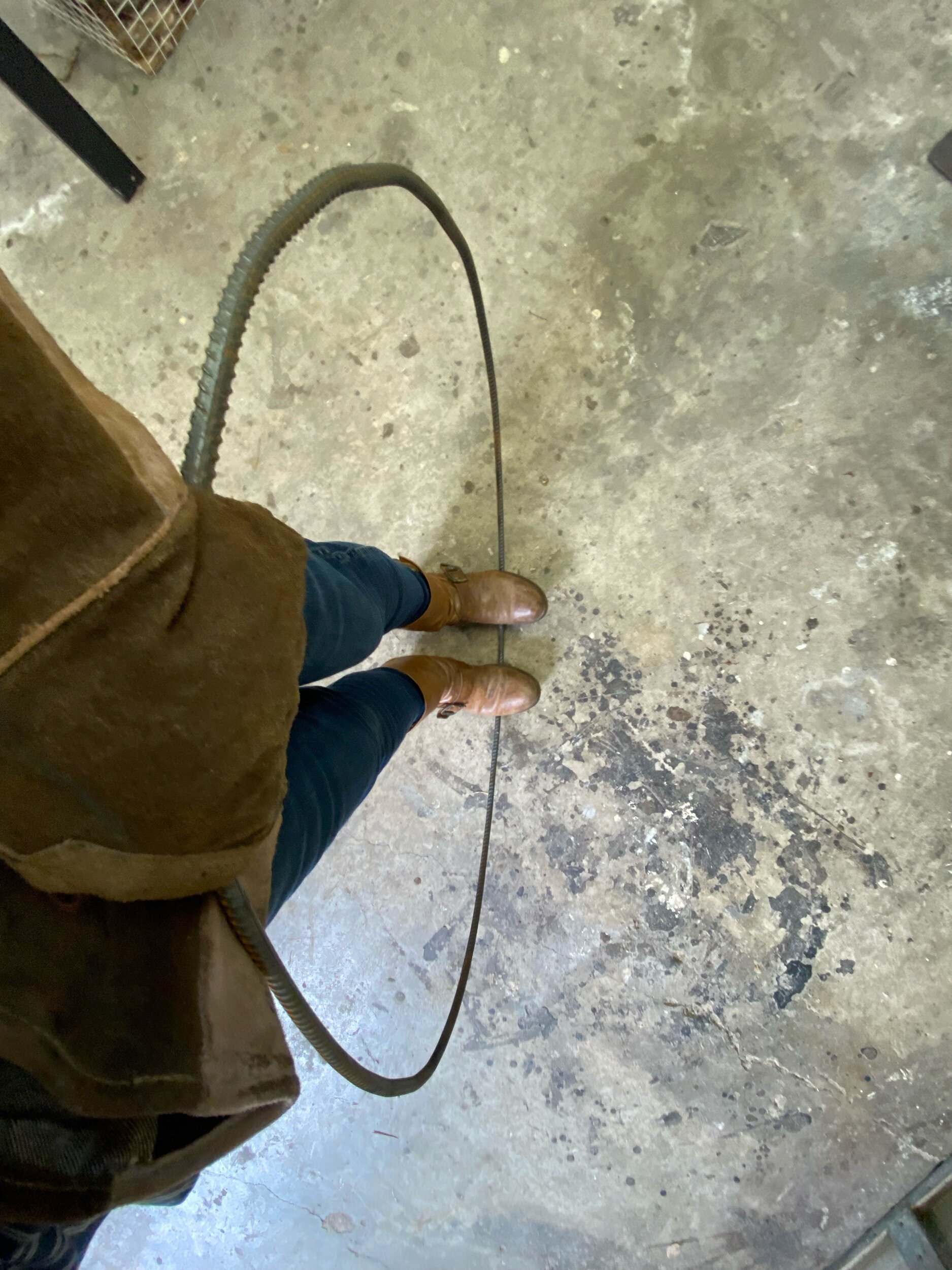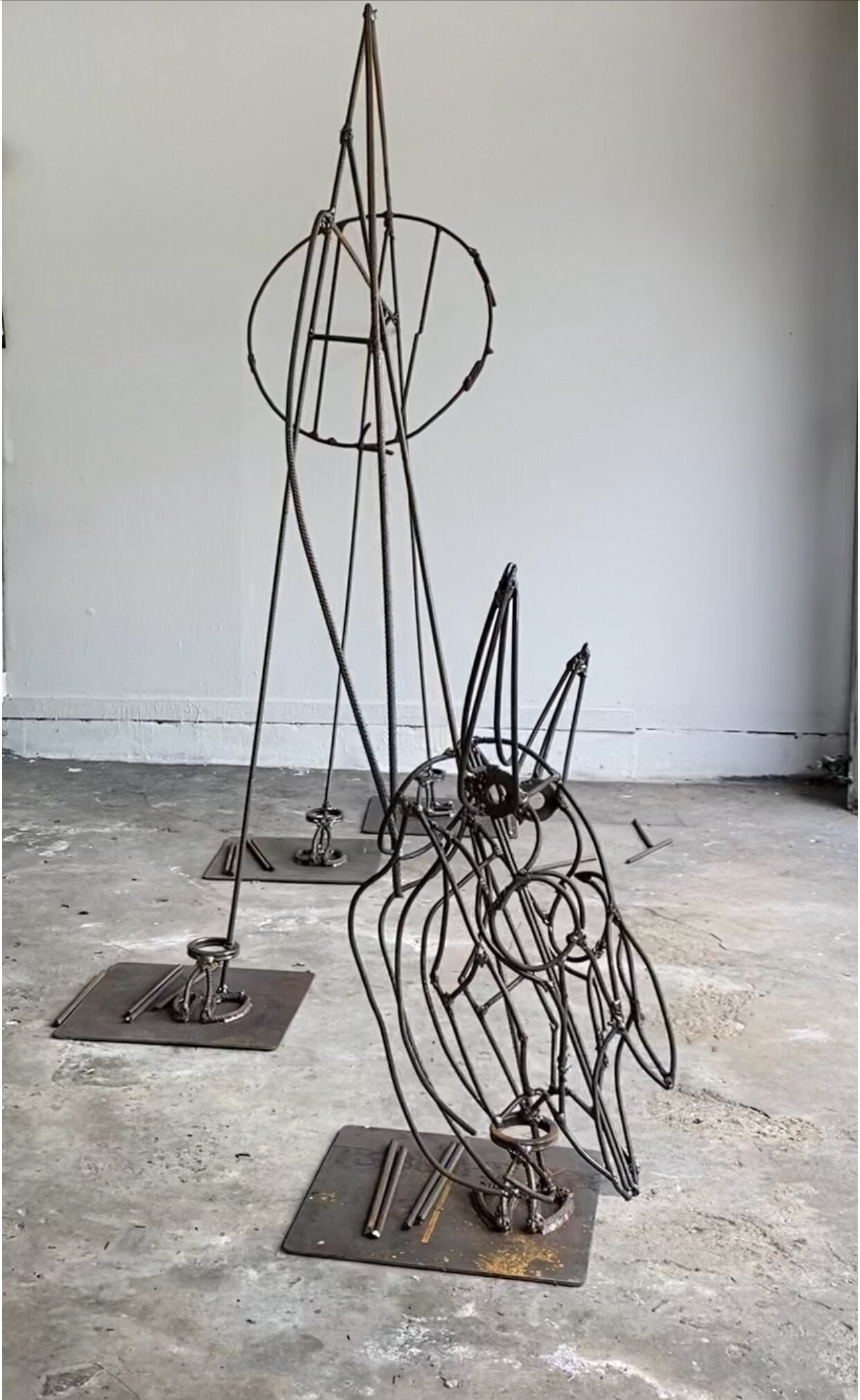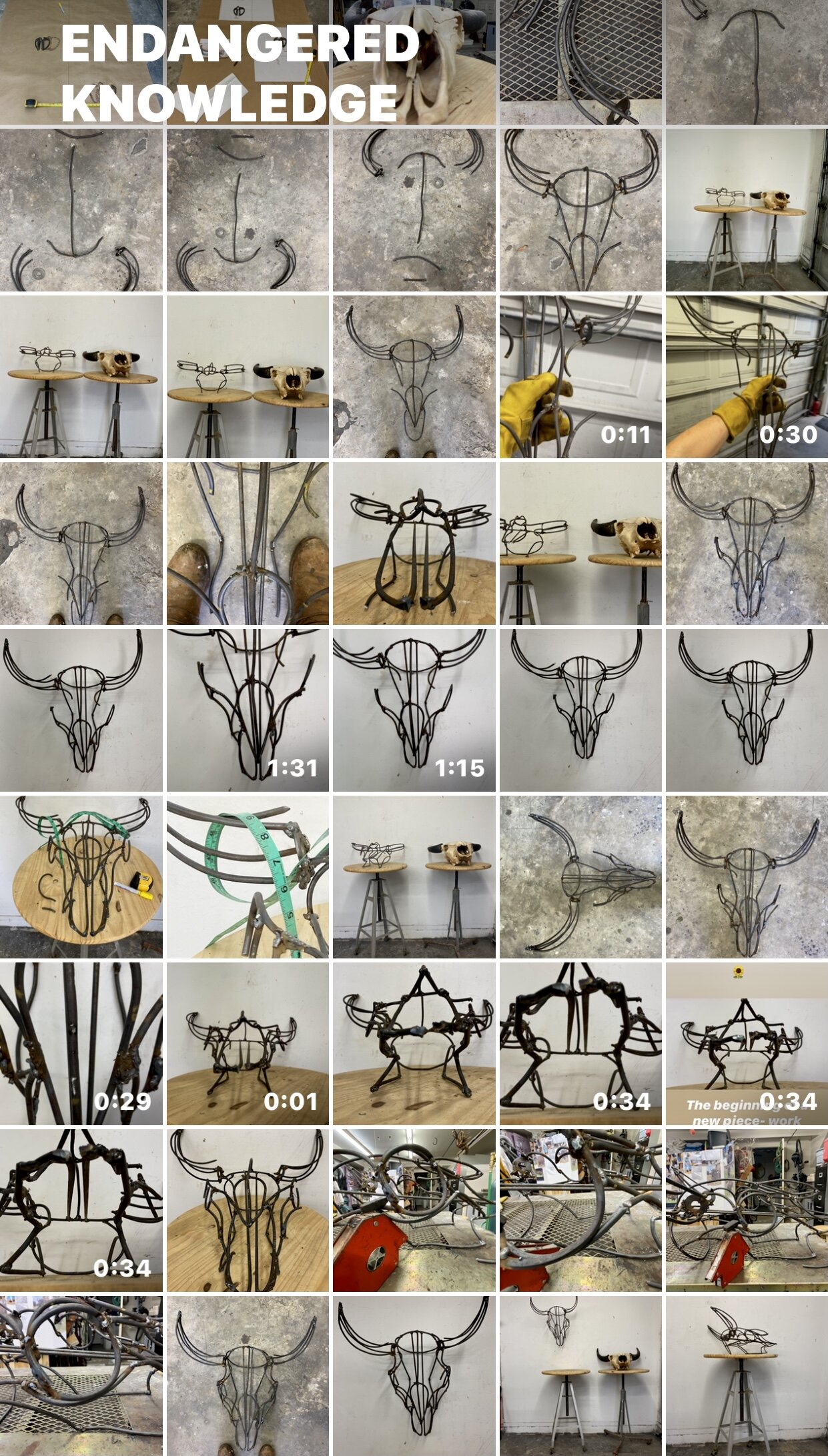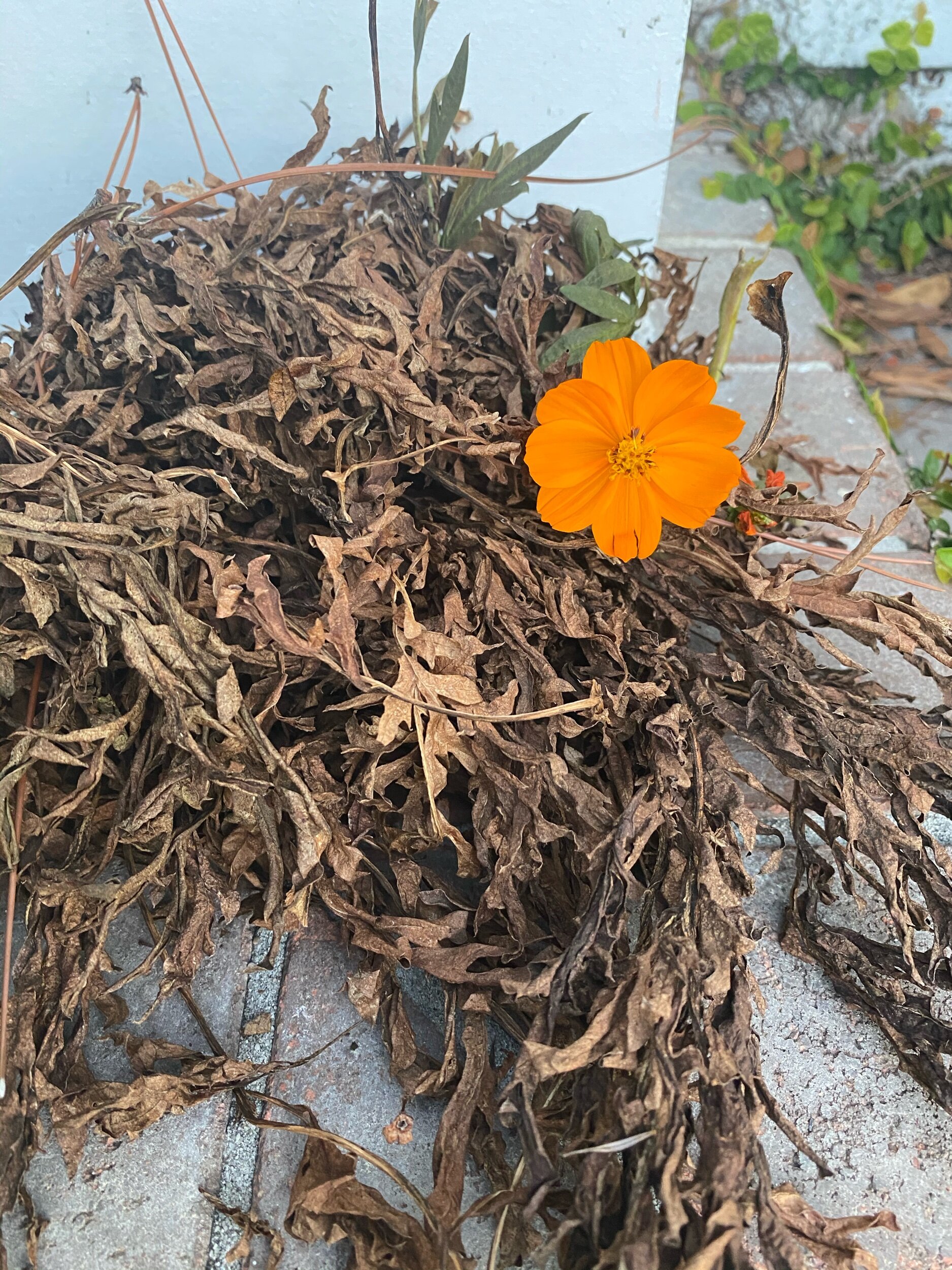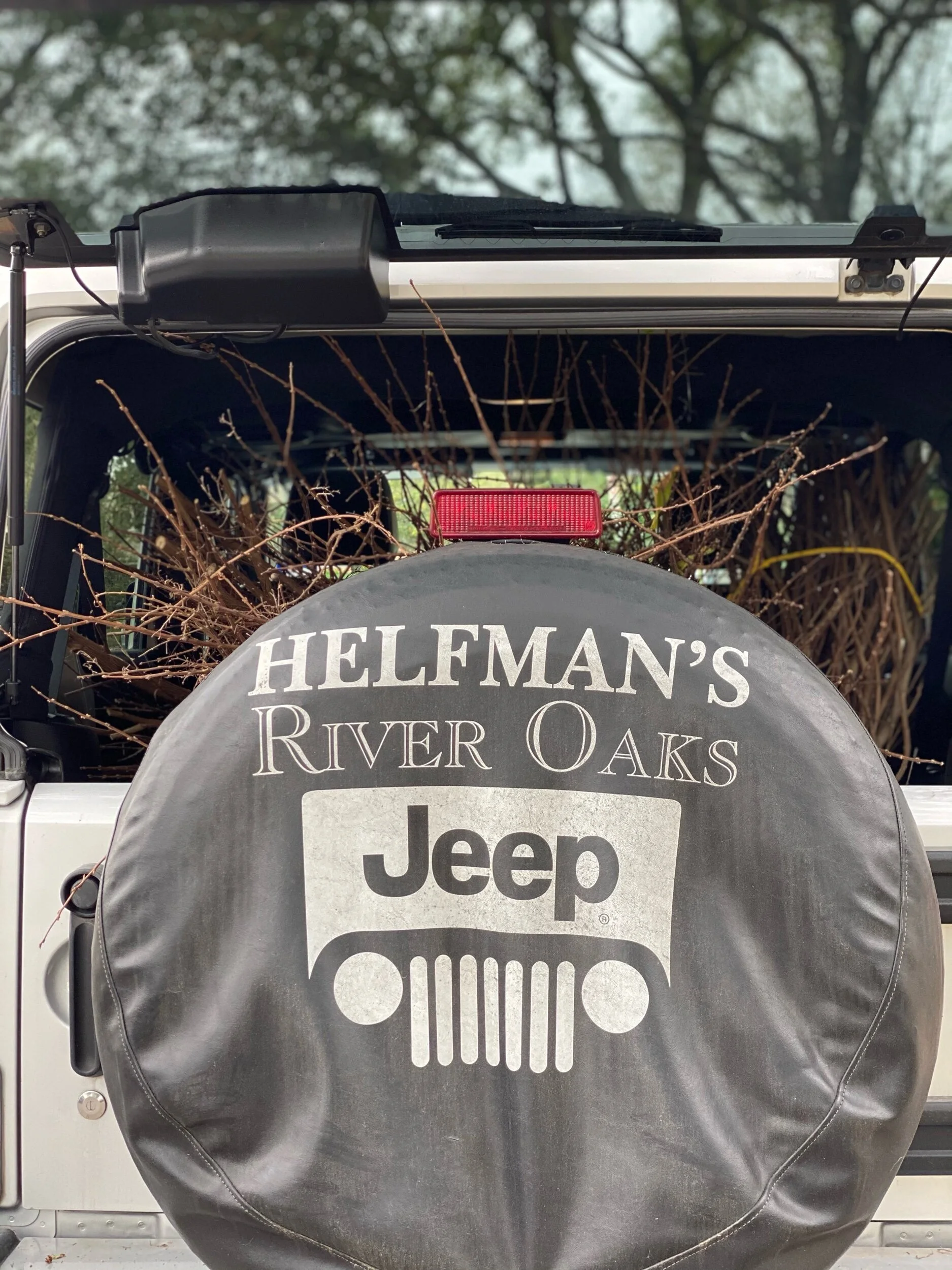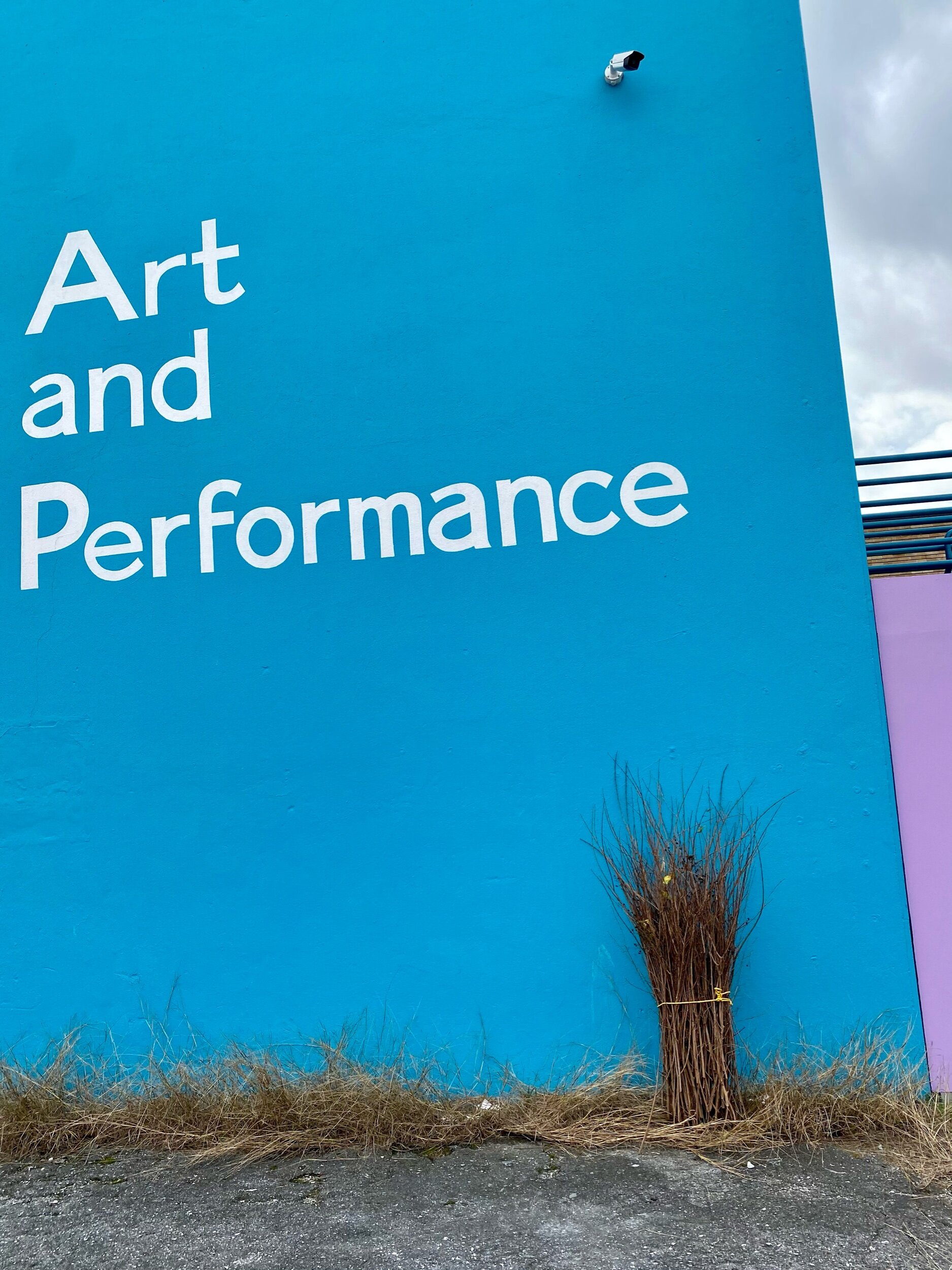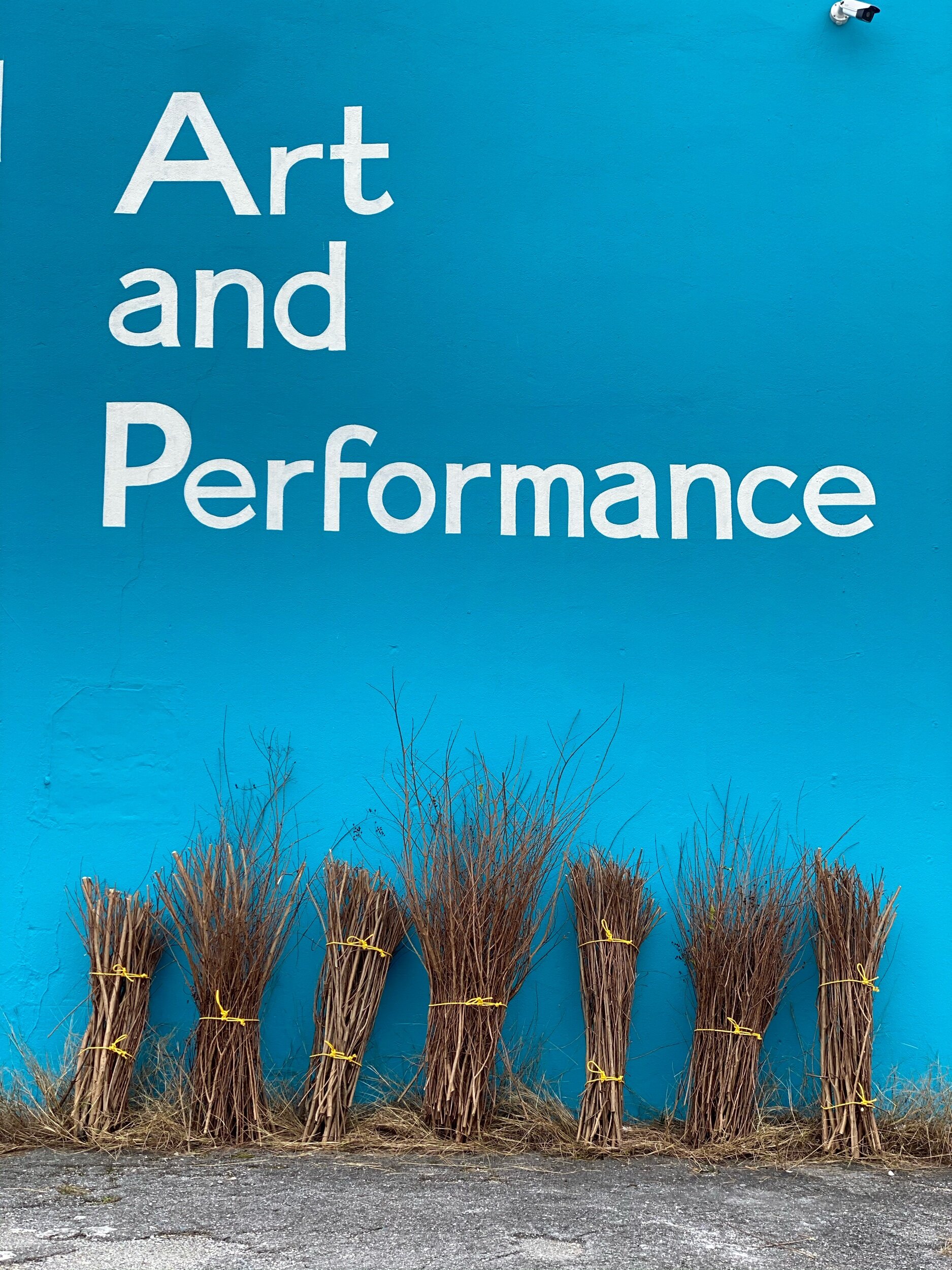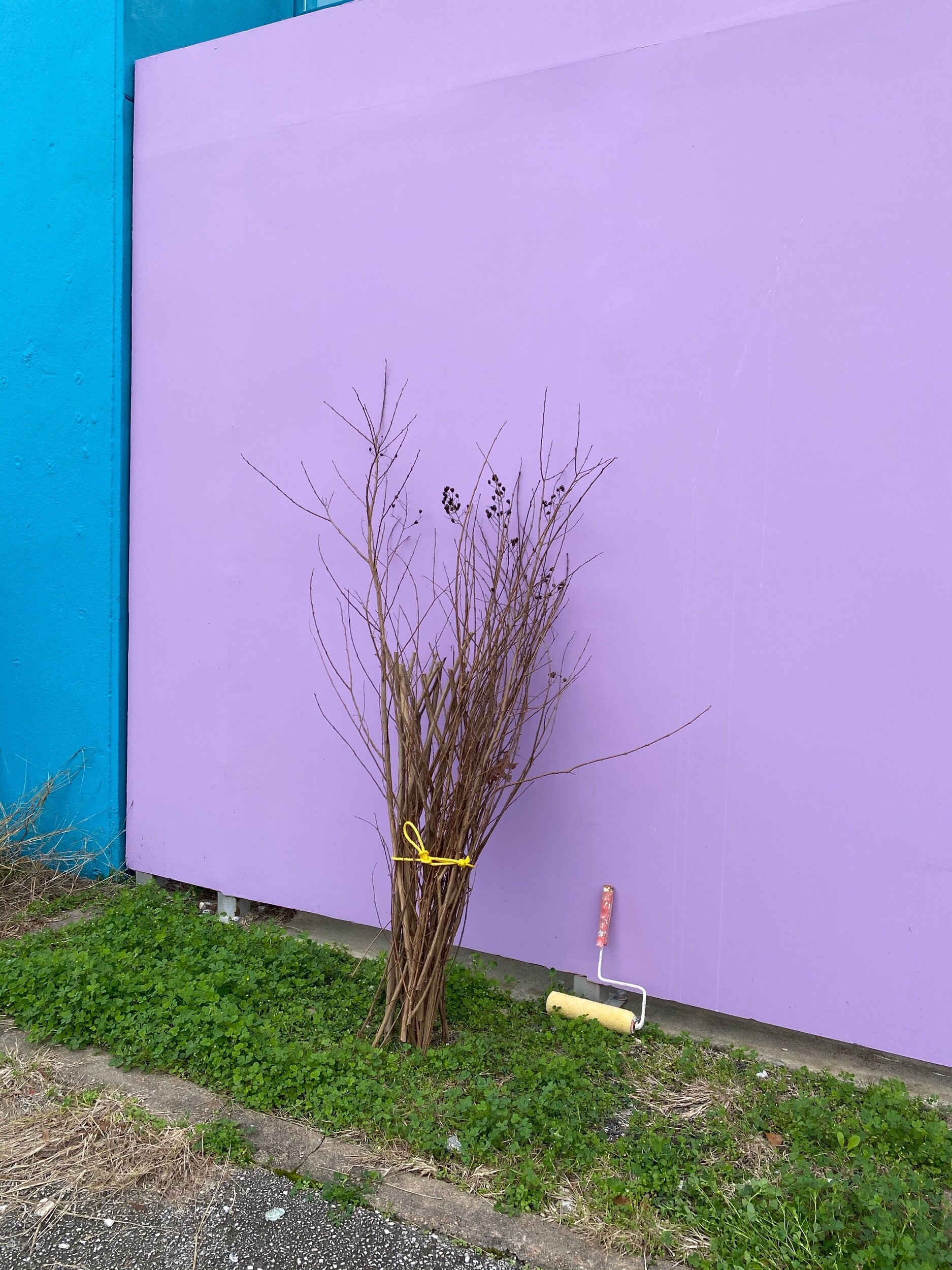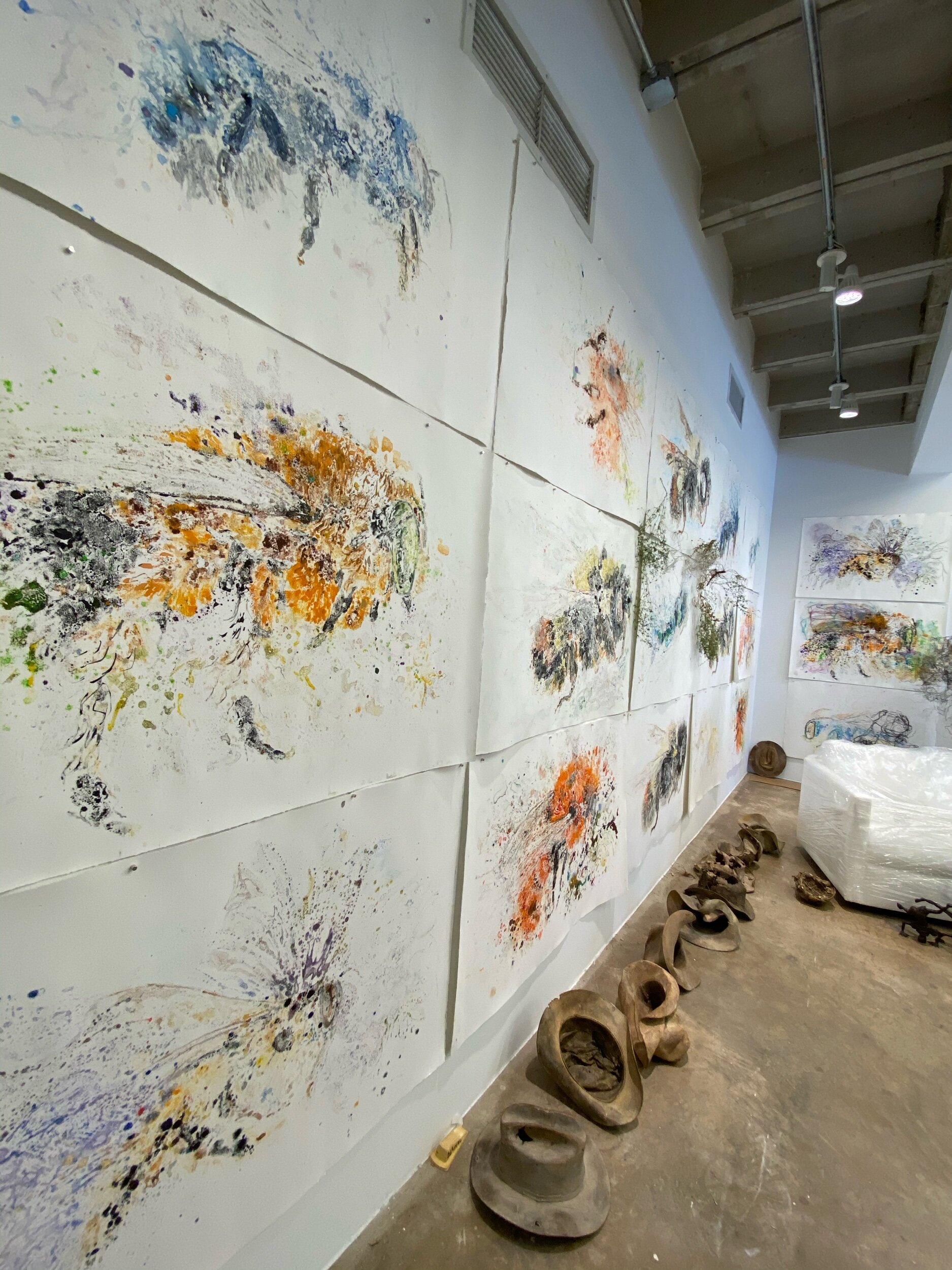Today‘s progress may not look like much, however I worked 7 hours. I was focused on filling the tiny spaces in the groin, inside its flanks and rear end. And I was careful not to catch my skin on the sharp edges of the late. It is razor-sharp and requires careful deliberate moves.
Endangered Knowledge: The Soul of Humus
I attach the lath with airplane safety wire. Think of lath as the skin. Once the armature is covered in lath/skin, I will add the fur/soil/dried native plants.
Endangered Knowledge: The Soul of Humus
Today's work
Yes, I use a sewing tape measure
I worked on his middle
Endangered Knowledge: The Soul of Humus
A few weeks ago Nash Baker took some in progress shots of my SMH piece. Then I had two weeks of off and on heat exhaustion. It is a rough summer to have an outdoor living sculpture and a piece that requires welding in a space that does not gave AC. I have finally replenished the minerals in my body and I am back to work on my bison. The temperatures are going to be extremely high this week to work outside. :(
Working on Endangered Knowledge: The Soul of Humus in my garage welding studio
Photo by Nash Baker
Symbiosis art activism update - landscape ordinance.
One of my goals as an artist is to inspire city Landscape policy change. Our cities landscape policy evolved before we had the telescopes to understand the living systems below ground. It is Necessary to update these policies that regulate or urban landscapes and utilize the power of out native landscape.
I have made great headways with discussions with city council person Sally Alcorn. She has supported my work and thoughtfully listens to what I am saying. I can see in her face and her actions that applying these regeneration agriculture principles to urban landscapes makes sense to her. She has worked in the city government for many years and understands how the machine works. She does not have landscape policy roots in her background which actually is a good thing, she does not have to unlearn. In the last few weeks, I have facilitated connecting her with two people in the native landscape world.
First Linda Knowles has led the native plant movement in Houston and Texas. She served on the cities committee for designated wildscapes and she has let the Houstin native plant society and is leading the Texas NPS. Linda is a great source of knowledge and will be a great resource for Sallie.
A few weeks ago I emailed Jaime González. Jaime is Houston Healthy Cities Program Director of The Nature Conservancy Texas Chapter – Houston Office. Jaime is everywhere when it comes to Houston native landscape. Within 5 minutes of emailing him about “Symbiosis” he called me. He wanted to see the work. We met the following day at 8:30 am. It was not too hot yet and we had a great conversation. He was amazed at what a hot bet of wildlife can be revived in the middle of a lifeless concrete urban desert - the museum district. :(. He Specifically, positively commented that I did not leave spaces of dirt separating each plant. I could hear frustration in his voice. It is a social custom to separate species. My goal is to keep the soil covered with a minimum of 1 layer of greenery if not many layers. Hearing him approve was a relief. He also made some plant suggestions for the southwest corner. It was a beautiful corner until the lemon bee balm faded for the season.
Tuesday this week I was able to connect him with Sallie and Hannah Cobb Public Affairs Liaison Office of Council Member Sallie Alcorn City of Houston, At-Large 5. It was a great conversation and I know Jaime will assist Sallie's office with their plans.
Like Jaime, Sallie is a mover- I just received an email from her office that she is meeting with Kelli Ondracek on September 1st to discuss a native landscaping pilot program. A giant leap - this feels good.
can art active change? :) I am trying.
What can changing city landscape policy do? Right now this is how most vacant lots look in houston. This is the vacant lot adjacent to Lawndale. The owner regularly grooms/mows it per city policy.
This vacant lot is actively sequestering carbon and soaking up water cooling the planet. This is responsible urban land management.
In addition it minimizes the need for mowing. I think it would be even better with a surrounding ground cover that did not requiring mowing.
Symbiosis — The Symmetry of Weeds, Ecosystem Services and Art Activism
In June the Lawndale Art Center opened the Big Show. I was very fortunate that nature was cooperating and Symbiosis was vibrant with both plants, pollinators and insects. The skies were full of dragonflies of every color, there was not a mosquito in sight. The bee balm was a bee crowd-pleaser and the passionflower was crawling in caterpillars. It felt good.
For approximately two weeks after Houston received large amounts of rainfall. Rain or shine I still went every day to observe the landscape, look for signs of new urban wildlife and learn from the work. I saw that a living sculpture is a moving target. During this time period, plenty of volunteer plants appeared, covering the spots of bare earth as nature knows is best. I diligently photographed the volunteer plants and researched them through my National Geographic citizen naturalist iNaturalist app. If they supported wildlife and they were in a location that they were not distracting I left them. If they were visually obtrusive or blocking another plant's growth or light. I pulled them. I winced with each pull, my instinct in regards to healthy soil and natural solutions was to leave them, they are sequestering carbon, any disturbance of soil releases carbon. Weeds have a role in the ecosystem: they establish quickly, protect exposed soil, provide habitat for beneficial organisms. Weeds are a natural response to heal disturbed earth. From an environmental point of view, they are a benefit to the landscape. From an artist's point of view, I love the weeds. They add a variety of line, an unexpected pop of color, movement, rhythm and a variety of patterns. As a sculptor interested in ways I can incorporate time snd movement in my work, I am a fan of weeds they are a design tool.
That said as an earth conservation art activist the purpose of the work is to inspire others to use native plants in urban landscapes. If the weeds turn people off before they learn about the work, the piece as art activism is a failure. Finding the balance, the symmetry with weeds continues to weigh heavily on my mind. I remind myself of the bigger picture—activate change, create a micro-ecosystem that others will be inspired to imitate. I know change can happen at lightning speed when innovation is coupled with imitation.
Phytolacca americana, also known as American pokeweed,
Detail of Phytolacca americana, American pokeweed,
Sesbania is a genus of flowering plants in the pea family, Fabaceae, and the only genus found in the tribe Sesbanieae. Riverhemp
a nitrogen fixer
“Nitrogen is the element responsible for lush green plant growth, but plants aren't actually able to use the nitrogen gas in Earth's atmosphere. Certain plant species, though, harbor bacteria in their roots that convert nitrogen from the atmosphere into a form that plants can absorb.“ learn more here.
Aesthetically as an artist this quiet corner of graceful movement is inspiring. The repeated surfboard shaped leaves delicately attached to the slender stem create a stunning rhythm and repeated pattern.
Jacquemontia tamnifolia Hairy cluster vine - insanely cool bloom, complex in its texture, shape, and color palett.
As stunning as this complicated vine’s bloom is I could not find anything about it it online, except it is capable of surviving fires. It does have the physical characteristics that attract bees, blue petals, and exposed stamen. I will take the risk and keep it. With any luck it will support at least one of pollinator species that we do not yet know we have lost. To return what we do not know we have lost is what inspires me to do this work.
I came across an invasive species, Fatoua villosa Hairy Crabweed. see future Symbiosis post
Endangered Knowledge: The Soul of Humus
Progress from the last two days of work.
Sagged bellie and manhood
Endangered Knowledge: The Soul of Humus
Ferlocks, hocks and nape
Right front leg chap and starting to build the neck muscles. The neck muscles are massive.
I build the legs on separate days. Left keg the hock curves up and right keg the Hock curves down. I still need fetlocks. I think bison have two per foot. More research
Endangered Knowledge: The Soul of Humus
Todays work- His right back haunch and leg.
Symbiosis- the tools of my collaborators
In creating a living sculpture, I have to accept change. I can not control the piece nor do I want to. From soil microbes to leaves, petals and butterflies, bees, skippers and caterpillars, I am always looking to the natural processes. I look to see what does the material want to make, what does it need to be. Competition, succession, disturbance, consumption are the sculpting tools of my collaborator, characteristics of the work. I have to let them follow their path to self-design their regenerating community. I bend my creative processes to the design principles developed through the ages on this planet for this place and time. The time is right to change how we landscape. I believe Houston is the right place and Houstonians the right people to plant the seeds.
Competition
Succession
Disturbance
Consumption
Endangered Knowledge: The Soul of Humus
Front legs and right shoulder
Endangered Knowledge: The Soul of Humus
20’ more of rebar.
I used 20’ more of rebar today to build the hip bones up on both sides and his right side in the stomach area of his side. I worked from the hip to his shoulder.
My work space is not large enough to get a good side photo.
Endangered Knowledge: The Soul of Humus
Stomach, upper hip bones, and more hump.
He still looks like a hybrid giraffe bison, that is only because his muscles and fur come later.
Endangered Knowledge: The Soul of Humus
Another big day of welding..I added a big 96” circumference chest. Put the entire piece on four dollies and started his hump. Below are a few pics from todays work.
Behind my garage is a telephone pole. I use it to bend my rebar. This is a side view where I am going to bend the piece for the chest.
Halfway to becoming a bison chest.
Then I use my weight to even out the shape.
I hang the chest over the back and decide if it is big enough.
Next I weld the ends together .
Recycling some old dollies from past work and deciding on the best plan. Balance and portability is the goal. The brown paper is the footprint of my bisons. Each leg is supported by a dollie.
Thanks to Curtis for getting me the plywood and helping me mount the beast. This is just for while I work on the sculpture and for transportation. It is not part of the work.
Just goofing around
My garage studio assistant is taking a sun break.
Starting to assemble the hump.
And that's a wrap.
Endangered Knowledge: The Soul of Humus
July 5th.
Attaching the head—
I welded just one connection from the neck to the head. As I assemble other parts of his body I will continue to evaluate the position of the head. I want him to be his reaching to the side searching for the next blades of grass within the reach of his massive head and tongue. With only one weld I can easily cut it off if I decide it is not in the right place or at the right angle. I do enjoy having a bobblehead bison in my garage for a while.
Building the girt—
I happened to have a circular scrap piece of rebar almost the right size. I created it years ago to be a round seat for a faux bois chair that was started and not finished. I turned it into the basis for the bison’s rear hip girth/stomach.
It is a little small, the small size gives me the flexibility to add to it exactly where I want it to protrude. As I get more elements worked out I will make it larger by adding the back hip bones that protrude. t is a lot easier to add pieces as I build him than to cut out pieces.
1 small tack world neck to head. Just to see where I want it.
Endangered knowledge: the Soul of Humus.
SMH fall of 2020 was canceled due to Covid 19 last July of 2020. I put a halt on welding my piece and focused on planning “Symbiosis.” “Symbiosis” is installed the Big Show is opened which provided a tremendous amount of traffic. I will still check on it every day, but I will spend most of my day building my piece for SMH 2021. Today I started where I left off. Below are images from last year's work and blog posts.
When I stopped in 2020 I had the hooves on steel plate bases and new where I wanted them to bare the weight.
Today I cut the rebar to form the lover part of the legs and grinded the tips. Tomorrow I weld.
Some of my notes from measuring Epics Bob the bison January of 2020.
My bison will be in motion not standing still.
The skull and upper jaw.
And lower jaw
4 pieces of rebar cut for each leg will provide the structure of the lower legs.
Endangered knowledge:The Soul of Humus
I dried some cosmos leaves to us as the coat of a sculpture that is in the works - Endangered knowledge: the Soul of Humus. The piece will be in the #sculpturemonthhouston 2021 exhibit. I started the armature during COVID for the SMH 2020 exhibit, which was postponed. The sculpture looks at the ecological history of the coastal prairie. This texture is perfect #cindeeklementart #endangeredknowledge #coastalprairie #tezasart #houstonart #bioart #environmentalart #cosmos #art #sculpture #bison
Root to Water- when science backs your art -Art that looks at science with a critical eye.
"It is clear that the past offers a vast repertoire of cultural knowledge that we cannot ignore," highlights Professor Boivin.
It is a different way to think of things; however they are on the right root. I have a feeling there will be more areas Root to Water intersects science.
ROOT TO WATER
12” X 18” X 12”
found objects: rusted steel irrigation wheel, root
photo by Nash Bake
Spontaneity and art - a good thing, we will see
I started my day at 6:30 am, pasting images of work into a word document for a curator/art consultant. A necessary task that I was thrilled to do- however, mind-numbing, to say the least. By 12:30 crossed eyed I took the dogs on a walk. When I came across this. My mind numbing was instantly healed with inspirational thoughts.
Seven immaculately bundled trimmings from a neighbors Crape, Myrtle. Crape murdered or not I- the trees were in the backyard, could not see them.
My trimmings from a site-specific installation @Lawndale Center for the Arts. Symbiosis
The image above is from last week at Lawndale (a post in am tardy with) My trimmings are wild and unruly. I am using them on social media to make a point - to change how we landscape- to landscape with habitat for wildlife in mind.
My neighbor's bundles of limbs are in sharp contrast to mine. They are an example of how controlling urban green spaces have become, the tidiness that is expected In our yards.
I am so tempted——— Such a great opportunity to turn these found object organic materials, perfectly assembled tied up with yellow cords into gorilla art. The colors will look amazing at Lawndale. It is not part of my work on Symbiosis to install anything I want. 🤔 The entire dog walk I was haunted by the bundles and their yellow cords. I am not comfortable installing gorilla art but I am excited with the idea and I know Lawndale won’t have me arrested like other institutions might if I randomly installed objects in their sculpture garden, right?
I have always challenged myself to take on the art that scares me the most- to embrace the butterflies as my son tells me. You don’t know until you try. - jump
I went to the door, I was hoping no one was home, Abby was a new neighbor and I introduced myself. - she moved in during Covid. We had a nice chat and she welcomed me to take her piles.
It took two trips
😁 when I bring new materials to Lawndale, I like to photograph them on this turquoise wall- documenting my materials. And I have to say! I love the colors - the Textures.
I declare this installation number 1. Untitled.
This technically is not Lawndale property, the wall is theirs, but the lot is unfortunately not owned by the institution. The lot is vacant. I get all the bundles out so I can pick up load number 2.
Installation number 2
Installation number 3
The yellow ties make my heart sing, that rich brown against the turquoise, and the golden grass softening the base, I am in heaven. I see ballerinas chins up, lined up to take their bows center stage. I had one left.
A painter from last week left their yellow roller- waste not want not. The clippings Are rich on the violet too.
Sometimes I feel guilty that I love my work so much.
Rumblings - work in progress-
Neonicotinoids disturb bumble bee and flies sleep and ability to know when to forage. It is banned in the EU and not in the US. This isn’t enough, these products used in urban gardens harm bees. Articles like these inspire me to plug on.
I have lost count
artist statements are also works in progress
as it sits
RUMBLINGS
Artist statement
A rumbling in the distance is nature's way to alert living creatures to their environment.
Rumblings is a work in progress, a monumental collection of fifty 30" X 44" watercolor monotypes that draw attention to the endangered knowledge of the 20,000 species of wild bees.
In these works, I carefully manipulate watercolor ink, and solvent into a chaos of infinitely miniscule paint particles. The materials are interconnected across the over-size monotypes, paralleling the synergistic, aqueous effects of the untold bee species' magnetic attraction to golden dust and their corresponding fragility due to the applied chemicals that flood residential gardens and industrial agriculture. Closely studying their exceptional ability to buzz and pollinate with their exceptional pollen-adhering bodies, I use abstraction and zoom in to depict the organized mayhem of their movements.
The installation of Rumblings inspires curiosity, alerting all viewers to pay attention, asking them to consider the unintended consequences of their actions in our-interconnected micro ecosystems. It is a resounding call to decrease pesticide usage, provide habitats for nesting, and plant native indigenous plants providing nectar for the bees that are responsible for 70% of the foods we eat.
What I do not know is when and where they will be installed, when that is in the picture I may find ways to connect the pieces visually. That will have an impact on the statement. Until the plant beautiful native plants.
















